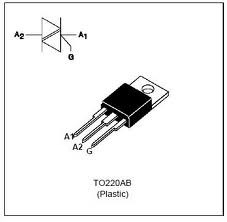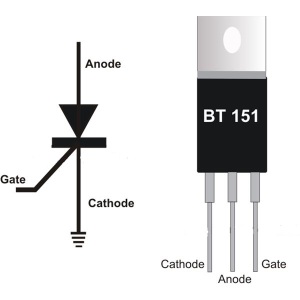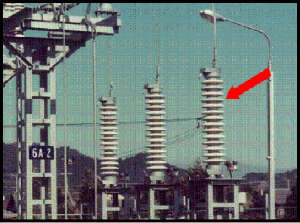Introduction to TRIAC
Triacs are widely used in AC power control applications. They are able to switch high voltages and high levels of current, and over both parts of an AC waveform. This makes triac circuits ideal for use in a variety of applications where power switching is needed. One particular use of triac circuits is in light dimmers for domestic lighting, and they are also used in many other power control situations including motor control.
The triac is a development of the thyristor. While the thyristor can only control current over one half of the cycle, the triac controls it over two halves of an AC waveform. As such the triac can be considered as a anti-parallel connection of thyristors with the two gates connected together and the anode of one device connected to the cathode of the other, etc.
Triac symbol for use in circuit diagrams

How does a triac work?
Before looking at how a triac works, it helps to have an understanding of how a thyristor works. In this way the basic concepts can be grasped for the simpler device and then applied to a triac which is more complicated.
For the operation of the triac, it can be imagined from the circuit symbol that the triac consists of two thyristors in anti-parallel to each other. The operation of the triac can be looked on in this fashion, although the actual operation at the semiconductor level is rather more complicated.

When the voltage on the MT1 is positive with regard to MT2 and a positive gate voltage is applied, one of the thyristors conducts. When the voltage is reversed and a negative voltage is applied to the gate, the other thyristor conducts. This is provided that there is sufficient voltage across the device to enable a minimum holding current to flow.
Comparison of SCR and TRIAC waveforms:
Advantages of TRIAC
1. Triac turns OFF when the voltage is reduced to zero.
2. Single gate controls conduction in both directions.
3. Triac with high voltage current ratings are available.
4. Triac is a bidirectional device, it conducts in both direction.
Disadvantages of TRIAC
1. Gate has no control over conduction once Triac is turned ON as in the case of an SCR.
2. Triac has very high switching delay.
3. Triac is not suitable for DC power applications.
Application
Low power TRIACs are used in many applications such as light dimmers, speed controls for electric fans and other electric motors, and in the modern computerized control circuits of many household small and major appliances .



























